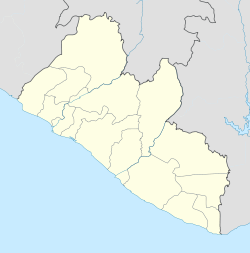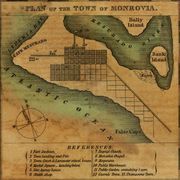Monrovia
- For alternate meanings, see Monrovia (disambiguation).
| Monrovia | |
|---|---|
| — City — | |
| City of Monrovia | |
 |
|
 Monrovia
|
|
| Coordinates: | |
| Country | |
| County | Montserrado County |
| District | |
| Established | April 25, 1822 |
| Named for | James Monroe -U.S. President |
| Government | |
| - Mayor | Mary Broh |
| Population (2008)[1] | |
| - Metro | 1,010,970 |
| Time zone | GMT (UTC+0) |
Monrovia is the capital city of the West African nation of Liberia. Located on the Atlantic Coast at Cape Mesurado, it lies within Montserrado County, the most populous county in Liberia. The metropolitan area, with a population of 1,010,970 in the Greater Monrovia District as of the 2008 census, contains 29% of the total population of Liberia and is the country's most populous city.[2] Monrovia is the cultural, political and financial hub for the entire country.
Founded in 1822, Monrovia is named in honor of U.S. President James Monroe, a prominent supporter of the colonization of Liberia. Along with Washington, D.C., it is the only other national capital to be named after a U.S. President. Monrovia was founded thirty years after Freetown, Sierra Leone, the first permanent African American settlement in Africa. The city's economy is dominated by its harbor, and government offices. Monrovia's harbor was significantly expanded by U.S. forces during the Second World War and the main exports include latex and iron ore. Materials are also manufactured on-site, such as cement, refined petroleum, food products, bricks and tiles, furniture and chemicals. Located near the confluence of the Mesurado and Saint Paul rivers, the harbor also has facilities for storing and repairing vessels.
Contents |
History


The area was already inhabited when it was named Cape Mesurado by Portuguese sailors in the 1560s. With the aim of establishing a self-sufficient colony for emancipated American survivors of slavery, something that had already been accomplished in Freetown, the first settlers from the United States under the auspices of the American Colonization Society arrived in Africa in 1821. They landed at Sherbro Island in present-day Sierra Leone. The undertaking was a shambles and many settlers died. In 1822, a second ship rescued the settlers and took them to Cape Mesurado, establishing the settlement of Christopolis. In 1824, the city was renamed to Monrovia after James Monroe, then President of the United States, and a prominent supporter of the colony in sending freed African-American slaves to Liberia, saw it as preferable than emancipation in America. It is the only non-American capital city named after a U.S. President.
In 1845, Monrovia was the site of the constitutional convention held by the American Colonization Society which drafted the constitution that would two years later be the constitution of an independent and sovereign Republic of Liberia.[3]
At the beginning of the 20th century, Monrovia was divided into two parts: (1) Monrovia proper, where the city's Americo-Liberian population resided and was reminiscent of the Southern United States in architecture; and (2) Krutown, which was mainly inhabited by ethnic Krus but also Bassas, Grebos and other tribes.[4] Of the 4,000 residents, 2,500 were Americo-Liberian. By 1926, ethnic groups from Liberia's interior began migrating to Monrovia in search of jobs.[5]
In 1979, the Organisation of African Unity held their conference in the Monrovia area, with then president William R. Tolbert as chairman. During his term, Tolbert improved public housing in Monrovia and decreased by 50% the tuition fees at the University of Liberia. A military coup led by Samuel Doe ousted the Tolbert government in 1980, with many members being executed.
The city was severely damaged in the Liberian Civil War, notably during the siege of Monrovia, with many buildings damaged and nearly all the infrastructure destroyed. Major battles occurred between Samuel Doe's government and Prince Johnson's forces in 1990 and with the NPFL's assault on the city in 1992. A legacy of the war is a large population of homeless children and youths, either having been involved in the fighting or denied an education by it.
Economy
The city's economy is dominated by its harbour. Monrovia is Liberia's financial centre. The Central Bank of Liberia is based in Monrovia.
Government
The city is home to the Monrovia City Corporation, which runs many services inside the city.
Former mayors include:
- W. F. Nelson, 1870s[6]
- C. T. O. King, 1880s and served three terms[7]
- H. A. Williams, 1890s[8]
- Gabriel M. Johnson, 1920s[9]
- Nathan C. Ross, 1956-1969[10]
- Ellen A. Sandimanie, 1970s and first woman to hold the position[11]
- Ophelia Hoff Saytumah, 2001–2009
Geography
Monrovia lies on a peninsula, between the Atlantic Ocean and the Mesurado River and is a major port. The Saint Paul River lies directly North of the city. Monrovia is located at . Monrovia is Liberia's largest city and its administrative, commercial and financial centre.
The city is located in Montserrado County however the small town of Bensonville is actually the capital of Montserrado County.
Climate
Under the Koppen climate classification, Monrovia features a Tropical monsoon climate. During the course of the year Monrovia sees a copious amount of precipitation. Monrovia averages 5,140 mm (202.3 in.) of rain per year. The climate features a wet season and a dry season, but precipitation is seen even during the dry season. Temperatures remain constant throughout the year averaging around 26 degrees Celsius (79 degrees Fahrenheit).
| Climate data for Monrovia | |||||||||||||
|---|---|---|---|---|---|---|---|---|---|---|---|---|---|
| Month | Jan | Feb | Mar | Apr | May | Jun | Jul | Aug | Sep | Oct | Nov | Dec | Year |
| Source: BBC Weather [12] | |||||||||||||
Culture and media

Attractions in Monrovia include the Liberian National Museum, the now ruined Masonic Temple, the Waterside Market (currently closed), cultural centre on Providence Island and several beaches. It is also home to a zoo. The city also houses Antoinette Tubman Stadium and the National Complex sports stadiums. The National Complex is one of the largest stadiums in Africa, with seats for 40,000.
Numerous tabloid style newspapers are printed on a weekly or bi-weekly basis, most of which are no more than 20 pages. Radio and TV stations are available, with radio being a more prominent source of news as problems with the electric grid make watching television more difficult. UNMIL Radio has been broadcasting since October 1, 2003. It is the first radio station in Liberia to broadcast 24 hours a day, and reaches an estimated 2⁄3 of the population.[13] STAR radio broadcasts at 104 FM.[14]
The Daily Talk is a compilation of news items and Bible quotations written up daily on a roadside blackboard in the Sinkor region of Monrovia.
Education
Monrovia is home to the University of Liberia, along with Cuttington College and Divinity School and many public and private schools.
Infrastructure

Boats link the city's Freeport of Monrovia, the country's busiest port, with Greenville and Harper.[15] The nearest airport is Roberts International Airport (the only international airport in Liberia), 60 km (40 mi) away at Robertsfield.[15] The city is connected with the rest of the country via a network of roads and railways. Monrovia is listed as the home port by between ten and fifteen percent of the world's merchant shipping, registered in Liberia under Flag of Convenience arrangements. Both private taxis and minibuses run in the city, and are supplemented by larger buses run by the Monrovia Transit Authority. Prior to the wars, the Mount Coffee Hydropower Project provided electricity and drinking water to the city.[16]
Neighborhoods
Over twenty neighborhoods crisscross Monrovia, home to not only Monrovians but residents from all fifteen counties. Several poor neighborhoods on Bushrod Island and Red Light Junction were developed as a direct consequences of Liberian Civil War. Reconstruction of roads, buildings and bridges have occurred in several neighborhoods in post war years. Newer neighborhoods several suburban towns and townships that have helped to alleviate large population within the original city limits. Today, many of these neighborhoods have been incorporated into the larger Monrovia metropolitan area.
|
|
|
|
See also
References
- ↑ 2008 National Population and Housing Census, accessed November 09, 2008
- ↑ GeoHive: Global Statistics
- ↑ Robin Dunn-Marcos, Konia T. Kollehlon, Bernard Ngovo, and Emily Russ (2005) in Donald A. Ranard (ed.) Liberians: An introduction to their history and culture (Washington: Center for Applied Linguistics) available online here
- ↑ Tiyambe Zeleza, Dickson Eyoh et al., Encyclopedia of Twentieth-Century African History
- ↑ Tiyambe Zeleza, Dickson Eyoh et al., Encyclopedia of Twentieth-Century African History
- ↑ "Trustees of Donations for Education in Liberia Records: 1842-1939". Massachusetts Historical Society. http://www.masshist.org/findingaids/doc.cfm?fa=fa0221. Retrieved 3 February 2010.
- ↑ Burrowes, Carl Patrick (2004). Power and Press Freedom in Liberia, 1830-1970. Africa World. pp. 117. ISBN 1592212948. http://books.google.com/books?id=FaEs88IpUzEC&pg=PA117&lpg=PA117&dq=mayors+of+monrovia+liberia+-broh&source=bl&ots=GfLUtMR-V7&sig=okGI4iuPB28fsfbcIbaYn1D0oG0&hl=en&ei=2EZpS62wGY_2sgOnq6SVBQ&sa=X&oi=book_result&ct=result&resnum=2&ved=0CAoQ6AEwATge#v=onepage&q=&f=false.
- ↑ Payne, Daniel Alexander (1922). A history of the African Methodist Episcopal church: being a volume supplemental to A history of the African Methodist Episcopal church. Book Concern of the A.M.E. Church. pp. 181. http://books.google.com/books?id=CATiAAAAMAAJ&pg=PA181&lpg=PA181&dq=mayors+of+monrovia+liberia+-broh&source=bl&ots=OIiHJDCzUh&sig=Fs_1VvXaw_Tn_fYiAJwPeR9mXzQ&hl=en&ei=WkVpS43nKJPkswPHncCfBQ&sa=X&oi=book_result&ct=result&resnum=7&ved=0CBkQ6AEwBjgU#v=onepage&q=&f=false.
- ↑ "African Series Introduction: Volume VIII: October 1913--June 1921". The Marcus Garvey and UNIA Papers Project. UCLA. http://www.international.ucla.edu/africa/mgpp/intro08.asp. Retrieved 3 February 2010.
- ↑ "Nathan Ross; Was Mayor Of Monrovia". The Washington Post. January 28, 2003.
- ↑ Thompson, Era Bell (January 1972). "Liberian Lady Wears Three Hats". Ebony: 54–62. http://books.google.com/books?id=C3VNev1_SpIC&pg=PA54&lpg=PA54&dq=mayors+of+monrovia+liberia+-broh&source=bl&ots=8WRi4iTxhi&sig=IV1pSEYmvlP-85WGzwRX0XqsIO4&hl=en&ei=LUVpS-HkG4eStgPhtuGZBQ&sa=X&oi=book_result&ct=result&resnum=3&ved=0CBEQ6AEwAjgK#v=onepage&q=&f=false.
- ↑ "Average Conditions Monrovia, Liberia". BBC Weather. http://www.bbc.co.uk/weather/world/city_guides/results.shtml?tt=TT000310. Retrieved August 18, 2009.
- ↑ [1]
- ↑ About us. STAR radio. Retrieved on October 13, 2008.
- ↑ 15.0 15.1 Timberg, Craig (March 12, 2008). "Liberia's Streets, Spirits Brighten; Four Years After War's End, Battered W. African Nation Begins a Slow Reawakening". The Washington Post: pp. A8.
- ↑ "Montserrado County Development Agenda". Republic of Liberia. 2008. http://www.emansion.gov.lr/doc/MontserradoCDA.pdf. Retrieved 2008-10-14.
External links
|
||||||||